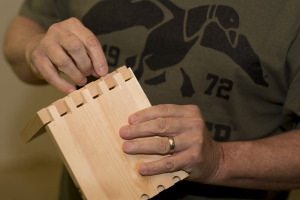
Routed to recovery — Fast response saves Mexico handyman from stroke
By Jacob Luecke
This story is featured in the Fall 2013 edition of myBoone Health magazine. Click here for a free subscription.
Down in his basement workshop, Russ Haerer holds his latest project. It’s a dovetail joint for a cabinet drawer.
It looks beautiful — but Russ isn’t satisfied.
“It’s a nice tight fit; it’s just not quite long enough on the ends,” he said.
Woodworking is Russ’ hobby. It’s an intricate pastime his hands have mastered over 30 years of practice. In this workshop, his hands have fashioned cabinets, furnishings and even outdoor décor.
But in early July, Russ’ left hand fell limp on his desk, immobile. He was suffering a large, sudden-onset stroke. In the past, such a stroke would have likely meant lifelong paralysis. Russ might have never built in his workshop again.
However, with a fast response, patients today can often leave the hospital days later without physical impairments.
As Russ grips his router, tracing a new pattern on his dovetail jig, he’s thankful for the simple ability to hold on with two hands.
“It sure makes everything easier,” he said.
A Major Stroke
In his day job, Russ works as an electrical engineer in the Columbia office of a global manufacturing company.
On July 2, he and his coworkers were returning to their desks after lunch.
As he walked to his desk, a blood clot silently and painlessly formed in his heart and traveled to his brain.
Unaware of what was happing, Russ, 57, continued chatting with his officemate. But as he talked, he realized he was badly slurring his words.
His colleague said Russ sounded really tired. But Russ wasn’t tired at all, he felt fine. The only thing unusual was a slight tingling sensation in his mouth.
 “I knew something was going on,” he said. “So I went to get up to go to the bathroom, but I couldn’t stand up.”
“I knew something was going on,” he said. “So I went to get up to go to the bathroom, but I couldn’t stand up.”
The entire left side of his body was numb. He couldn’t move.
“I tried to pick up my left arm and my hand felt like it had a sandbag on it,” he said.
Russ was displaying the classic symptoms of a major stroke: face drooping on one side, inability to raise one arm and slurred speech.
He also felt no pain. This is common; strokes are often painless. Many people actually delay seeking care during a stroke because nothing hurts. But that decision can be calamitous.
“Stroke treatments are very time-dependent,” said neurologist Allyn Sher, MD, medical director of Boone Hospital’s Stroke Center. “For every minute a stroke is left untreated, the average patient loses almost 2 million neurons.”
Fortunately, Russ’ coworkers quickly called for help. Before long, an ambulance crew was taking him to Boone Hospital’s Stroke Center, which has been rated at the gold level by both The Joint Commission and the American Heart Association.
At Boone Hospital, physicians performed a CT scan on Russ’ brain to check for any bleeding — there was none. Dr. Sher then injected Russ’ arm with medication containing a tissue plasminogen activator, a clot-busting drug commonly called tPA.
The drug has done wonders for stroke patients since it was approved in 1996. It’s used regularly by Boone Hospital’s stroke team, which treats roughly one new stroke case every day.
In addition to administering tPA, Boone Hospital’s specialists can also perform advanced mechanical clot removal techniques needed in some stroke cases.
For Russ, because he arrived at Boone Hospital quickly, the tPA worked like a miracle.
Within 24 hours he could speak clearly. Soon his motor function was completely restored, and there was no need for physical therapy. He left the hospital four days after his stroke.
Dr. Sher attributes Russ’ success to his colleagues at work who recognized he was having a stroke and quickly called for help.
“If someone comes in very quickly and is able to get the drug, the odds are very high they can leave without a deficit,” he said.

|
|
Russ in his shop. |
In His Workshop
Back at his home in Mexico, Mo., Russ said he’s now very aware of the stroke warning signs.
He has a long history of atrial fibrillation, abnormal heart rhythms, which put him at greater risk for having a stroke.
If he has a repeat occurrence, as one in four stroke patients do, he knows his ability to continue doing the things he loves depends on getting to the hospital. The faster, the better.
It’s something he’s going to watch closely because he has plenty left to do in his workshop.
Between his wife, three kids and three grandkids, he has a growing waiting list for his beautiful hand-made furniture.
“I think I’m about three Christmases behind now,” he said, with router in hand.

|
|
Russ and his grandchildren. |